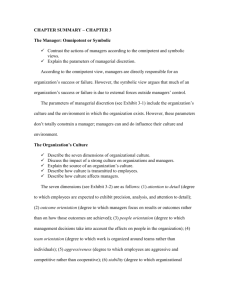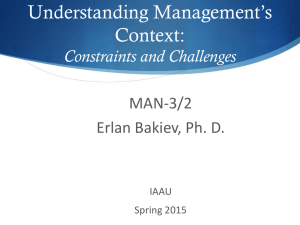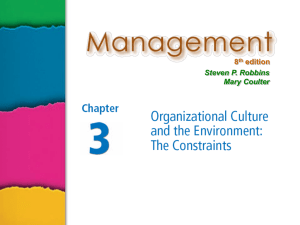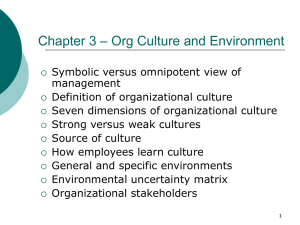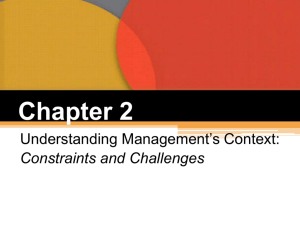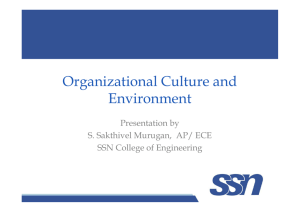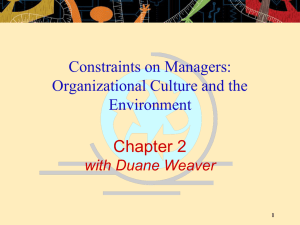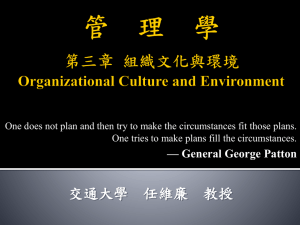CHAPTER SUMMARY – CHAPTER 3 - UL2011-2012
advertisement
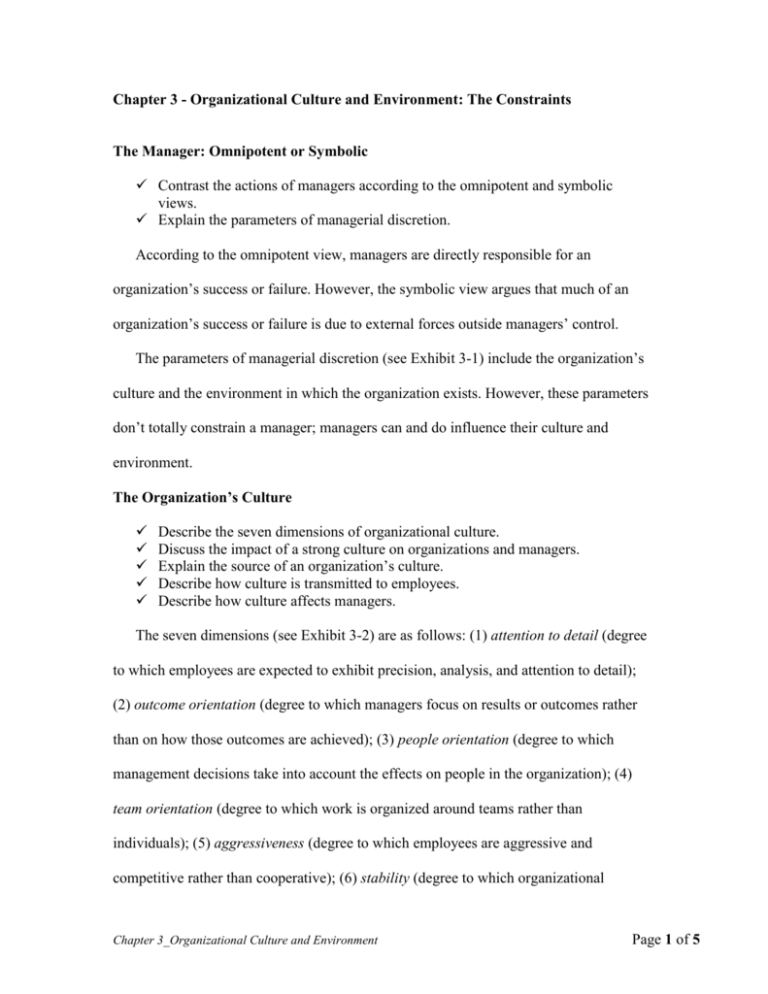
Chapter 3 - Organizational Culture and Environment: The Constraints The Manager: Omnipotent or Symbolic Contrast the actions of managers according to the omnipotent and symbolic views. Explain the parameters of managerial discretion. According to the omnipotent view, managers are directly responsible for an organization’s success or failure. However, the symbolic view argues that much of an organization’s success or failure is due to external forces outside managers’ control. The parameters of managerial discretion (see Exhibit 3-1) include the organization’s culture and the environment in which the organization exists. However, these parameters don’t totally constrain a manager; managers can and do influence their culture and environment. The Organization’s Culture Describe the seven dimensions of organizational culture. Discuss the impact of a strong culture on organizations and managers. Explain the source of an organization’s culture. Describe how culture is transmitted to employees. Describe how culture affects managers. The seven dimensions (see Exhibit 3-2) are as follows: (1) attention to detail (degree to which employees are expected to exhibit precision, analysis, and attention to detail); (2) outcome orientation (degree to which managers focus on results or outcomes rather than on how those outcomes are achieved); (3) people orientation (degree to which management decisions take into account the effects on people in the organization); (4) team orientation (degree to which work is organized around teams rather than individuals); (5) aggressiveness (degree to which employees are aggressive and competitive rather than cooperative); (6) stability (degree to which organizational Chapter 3_Organizational Culture and Environment Page 1 of 5 decisions and actions emphasize maintaining the status quo); and (7) innovation and risk taking (degree to which employees are encouraged to be innovative and to take risks). Research results are suggesting that in organizations with strong cultures: employees tend to be more committed to their organizations; recruitment efforts and socialization practices are used to build employee commitment; and there is higher organizational performance. The impact of a strong culture on managers is that as the culture becomes stronger, it has an increasing impact on what managers do and constrains their decisionmaking options as they plan, organize, lead, and control. An organization’s culture and general way of doing things are largely the result of what it has done before and how successful it has been doing things that way. The original source of the culture usually reflects the vision or mission of the organization’s founders. (See Exhibit 3-5.) Culture is transmitted to employees through stories (narratives of significant events or people); rituals (repetitive sequences of activities); material symbols (objects, facilities, and other aspects of the physical work environment); and language (special and unique terms, acronyms, and jargon). These elements help employees “learn” what values and behaviors are important as well as who exemplifies those values. Culture affects how managers plan, organize, lead, and control. (See Exhibit 3-6.) Current Organizational Culture Issues Facing Managers Describe the characteristics of an ethical culture, an innovative culture, and a customer-responsive culture. Explain why workplace spirituality seems to be an important concern. Describe the characteristics of a spiritual organization. Chapter 3_Organizational Culture and Environment Page 2 of 5 A culture that is most likely to shape high ethical standards is high in risk tolerance, low to moderate in aggressiveness, and focuses on means as well as outcomes. An innovative culture is characterized by the following: challenge and involvement, freedom, trust and openness, idea time, playfulness/humor, conflict resolution, debates, and risktaking. A customer-responsive culture has six characteristics: employees who are outgoing and friendly; few rigid rules, procedures, and regulations; widespread use of empowerment; clear roles and expectations; and employees who are conscientious in their desire to please the customer. Workplace spirituality is important for the following reasons: employees are looking for ways to counterbalance the stresses and pressures of a turbulent pace of life; people are looking for involvement and connection that they often don’t find in contemporary lifestyles; aging baby boomers are looking for something meaningful in their lives; and for some people, organized religion hasn’t fulfilled their needs. Spiritual organizations tend to have five characteristics: strong sense of purpose, focus on individual development, trust and openness, employee empowerment, and toleration of employee expression. The Environment Describe the components of the specific and general environments. Discuss the two dimensions of environmental uncertainty. Identify the most common organizational stakeholders. Explain the four steps in managing external stakeholder relationships. The specific environment (those external forces that have a direct impact on manager’s decisions and actions and are directly relevant to an organization’s goals) includes customers, suppliers, competitors, and pressure groups. The general environment (those broad external forces that affect the organization) includes economic, Chapter 3_Organizational Culture and Environment Page 3 of 5 political/legal, sociocultural, demographic, technological, and global conditions. (See Exhibit 3-9.) The two dimensions of environmental uncertainty include degree of change (stable or dynamic) and degree of complexity (simple or complex). (See Exhibit 3-11.) Stakeholders are any constituencies in the organization’s environment that are affected by the organization’s decisions and actions. The most common ones are customers, social and political action groups, competitors, trade and industry associations, governments, media, suppliers, communities, shareholders, unions, and employees. (See Exhibit 3-12.) The four steps in managing stakeholder relationships are (1) identifying the organization’s stakeholders; (2) determining the interests or concerns these stakeholders might have; (3) deciding how critical each stakeholder is to the organization’s decisions and actions; and (4) determining how to manage those stakeholders. Chapter 3_Organizational Culture and Environment Page 4 of 5 Chapter 3 – Key Terms omnipotent view of management The view that managers are directly responsible for an organization’s success or failure. symbolic view of management The view that much of an organization’s success or failure is due to external forces outside managers’ control. organizational culture The shared values, principles, traditions, and ways of doing things that influence the way organizational members act. strong cultures Organizational cultures in which the key values are intensely held and widely shared. socialization The process that helps employees adapt to the organization’s culture. workplace spirituality A culture where organizational values promote a sense of purpose through meaningful work that takes place in the context of community. external environment Those factors and forces outside the organization that affect the organization’s performance. specific environment Those external forces that have a direct impact on managers’ decisions and actions and are directly relevant to the achievement of the organization’s goals. general environment Broad external conditions that may affect the organization. environmental uncertainty The degree of change and complexity in an organization’s environment. environmental complexity The number of components in an organization’s environment and the extent of the organization’s knowledge about those components. stakeholders Any constituencies in the organization’s environment that are affected by the organization’s decisions and actions. Chapter 3_Organizational Culture and Environment Page 5 of 5

